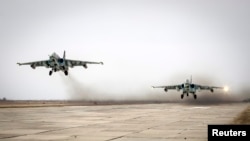Russia’s relations with the West have sunk to the lowest level since the end of Cold War, since Russia’s annexation of the Crimean peninsula in 2014 and Moscow's involvement in continuous armed conflict in eastern Ukraine, in which it is providing support for separatist rebels who are fighting Kyiv government forces.
Last month, Russia held war games that exacerbated even further its ties with NATO, the European Union and the United States.
The drills, with tens of thousands of troops, took place in regions spanning the country, from the Arctic to the Far East to the volatile southern Caucasus, triggered eerie feelings in Russia’s neighboring countries, the Baltic states, once part of the Soviet Union, Poland, formerly within its orbit, and in Scandinavian countries.
NATOSource Director and Brent Scowcroft Center Senior Fellow at the Atlantic Council Jorge Benitez said that Russian military activities along the Finnish border, the deployment of strategic weapons systems to Kaliningrad and Crimea, and positions across the Baltic Fleet, Black Sea Fleet, and in the western and southern military districts, mimicked a full-scale attack against Europe.
In short, Russian military exercises have taken on a threatening posture, Benitez said in an interview with VOA Serbian Service.
“These maneuvers are very dangerous. They are provocative; they are excessive both in the size and in their frequency. The West, the NATO members are creating maneuvers of a few hundred, and a few thousand troops for training exercises,” Benitez said.
Russia doubled its troops at its most recent maneuvers from initially 40,000 to 80,000. Last September, its military drills in the Far East, dubbed “Vostok-2014,” included 100,000 troops and were the largest since the Soviet era. In addition, up to 1,500 tanks, 120 aircraft, 5,000 pieces of weaponry, military and special hardware, and up to 70 ships took part in the exercises.
Russia is regularly exercising tens of thousands of troops that “do not seem to have defensive purposes,” said Benitez.
For last month’s military drills, Benitez argued that the areas involved and the forces included seem to have been deliberately chosen to send a warning to NATO.
“He [Putin] is probing NATO, not just militarily but also politically. He is trying to make the message of ‘I’m closer to your allies. I have a much larger military in this area and I can play a much quicker role in deciding on how I can deal with these things,’” Benitez said. NATO exercises are planned days, weeks and months, sometimes years, in advance, he noted, while Russia is conducting military exercises “on 24-hour notice.”
The deployment of ballistic missiles and bomber aircraft are provocative indicators of possible pre-emptive action against NATO and Eastern Europe, contends Benitez.
“It has to be made clear to Russia that any aggression against the Baltic allies would lead to a major war with the West. It has to remind and make very clear and transparent to Moscow and to Mr. Putin himself that any military aggression against any allies, specifically the Baltics, will be met by all of the Alliance working to defend them,” said Benitez
He warned that just as the U.S. does not seek a confrontation with Russia that would escalate into a nuclear exchange, Russia should also “keep in mind that it should not provoke a conflict with NATO that would lead to a nuclear conflagration.”
Poland and the three Baltic countries — Estonia, Latvia and Lithuania — are increasing military spending and have asked NATO allies, particularly the United States, to step up their presence.
NATO is already conducting air policing missions in its Baltic members bordering Russia. To counter Russian military drills in the Baltic and Black Sea regions, the alliance is strengthening defense capabilities on its eastern flank with a force of 5,000 troops and command centers in Bulgaria, Poland and Romania.
Norway, a NATO member, spent 1.4 percent of its GDP on the military under the premiership of NATO Secretary General Jens Stoltenberg. As Moscow conducted massive drills in the Arctic area near Norway’s border in March 2015, the county held its own exercise, dubbed "Joint Viking" also in March.
Neither Finland nor Sweden are members of the alliance, but both have raised the possibility of joining NATO. Further, Sweden has deployed troops to the strategically located Gotland Island. It has expressed intent to boost its submarine fleet after its armed forces failed to find a suspected Russian mini-submarine in the Stockholm archipelago in October 2014.
VOA’s Serbian Service contributed to this report.
